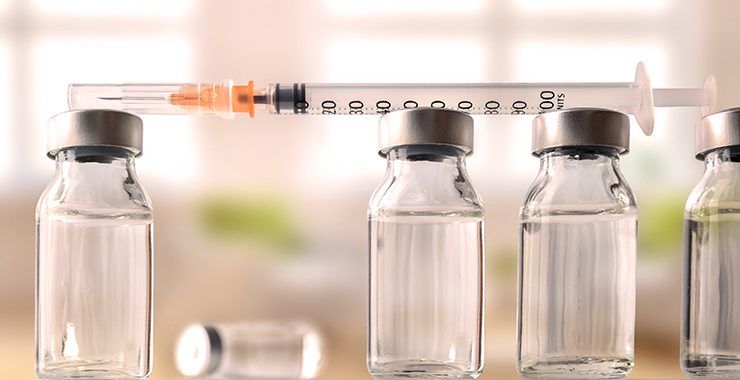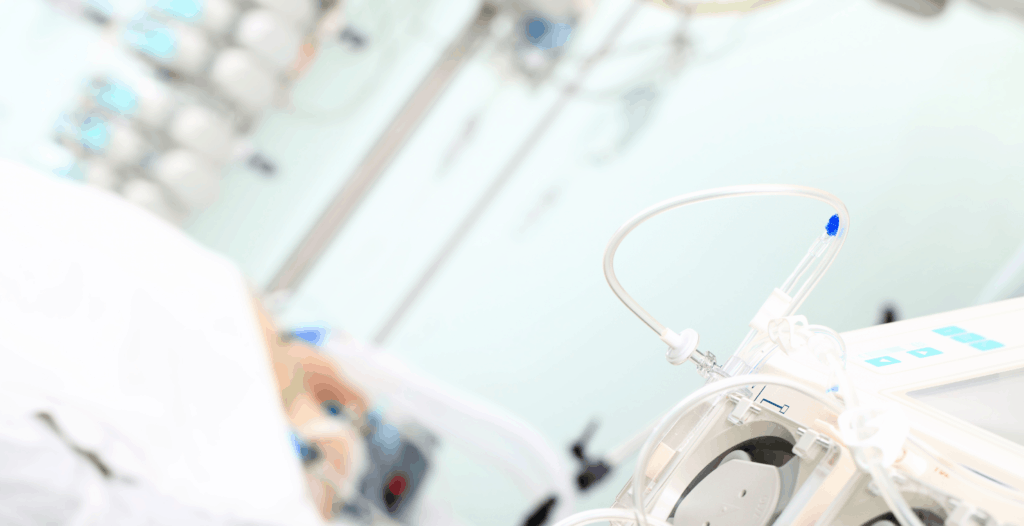Intravenous Vancomycin
In this article:
Vancomycin is an antibiotic originally isolated from the bacteria Streptococcus orientalis.
It was discovered in the 1950’s but became a preferred treatment against infections resistant to other antibiotics, particularly penicillin-resistant staphylococcal infections.
Vancomycin is a tricyclic glycopeptide antibiotic that prevents synthesis of peptidoglycan, the main component of bacterial cell walls.
It is an effective antibiotic treatment against Gram-positive bacteria that contain peptidoglycan in their walls.
Uses of Intravenous Vancomycin
Oral vancomycin is given to treat Clostridiodes (Clostridium) difficile infections and infection-induced diarrhea.
However, the drug has poor oral bioavailability and is broken down in the stomach and intestines before it can enter the bloodstream to treat systemic infections.
As a result, for systemic infections, vancomycin is given intravenously (IV) for better efficacy.
The Food and Drug Administration (FDA) has approved IV-administered vancomycin to treat bacterial infections, from:
- methicillin-resistant Staphylococcus aureus (MRSA)
- methicillin-resistant Staphylococcus epidermis (MRSE)
- Enterococcus faecalis
MRSA and MRSE are both resistant to beta-lactam antibiotics (for example, oxacillin), which are commonly used to treat most staph infections.
Intravenous vancomycin can also be used for a variety of other serious or severe infections, including:
- Skin and soft tissue infections
- Lower respiratory tract infections
- Blood poisoning (septicemia)
- Bone infections
- Infection of the inner lining and valves of the heart (endocarditis)
- Bacterial meningitis
- Intra-abdominal infections due to MRSA
Vancomycin is often used to treat other conditions off-label, such as:
- Prosthetic joint infections
- Surgical site infections
- Necrotizing skin and soft tissue infections
- Prevention of surgical site infections
- Prevention of Group B streptococcal infections in newborns
- Bacterial infections in the eye (bacterial endophthalmitis)
Vancomycin is also useful for treating infections in patients allergic to penicillin or cephalosporins.
It is important to note that vancomycin and other antibiotics are not effective in treating viral infections.
Dosing of Intravenous Vancomycin

New vancomycin dosing guidelines for the treatment of serious MRSA infections were published in 2020 by several leading pharmacy and infectious disease groups.
They recommend that non-obese adults with normal kidney function receive a starting dose of 15 to 20mg/kg IV (based on actual body weight) given every 8 to 12 hours.
In non-obese children with normal renal function who are 3 months to less than 12 years, the recommended dose is 60-80mg/kg/day given in divided doses given every 6 hours.
For non-obese children who are 12 years and above, the recommended dose is 60-70mg/kg/day, given in divided doses every 6 to 8 hours.
In elderly patients and/or those with impaired kidney function, the dose of vancomycin is reduced.
Patients who are considered obese may require higher doses.
Vancomycin is processed in the kidneys, and too much drug given at once can be damaging. In all cases, further dosing should be guided by blood concentrations.
For seriously ill patients, the guidelines suggest consideration of a loading dose which by definition is a one-time large dose that is given to a patient who is starting with no vancomycin in their blood.
In non-obese adults with normal kidney function, they recommend a loading dose of 20-35mg/kg/day, with a maximum dose of 3000mg given in a single dose.
For non-obese children and neonates, a loading dose is not recommended.
If the adult patient is obese, loading doses of 20-25mg/kg using actual body weight, up to 3000mg may be considered.
For obese pediatric patients, the recommended dose is 20mg/kg based on total body weight.
In order for vancomycin to work correctly, a certain concentration needs to be maintained in the blood.
Vancomycin has a narrow therapeutic window, and it is easy to underdose or overdose a patient.
Blood work is done to ensure vancomycin trough levels remain within this window to prevent organ damage or antibiotic resistance.
This also helps to determine when the next dose should be administered to the patient. Every person will process vancomycin at a different rate and dosing can be tailored to an individual patient.
Recent pharmacokinetic studies have provided an equation for estimating daily maintenance dosing of vancomycin in obese patients.
The updated approach now takes into account age, sex, body weight and serum creatinine (Scr).
The proper dose of IV vancomycin should be administered slowly over at least 60 minutes at a rate of 10 mg/minute to prevent adverse infusion reactions.
The dosing frequency of IV vancomycin is typically every 6 to 24 hours.
It can be given every 8 hours to neonates.
In healthy patients, the half-life of vancomycin is between 4 to 6 hours; in patients lacking functional kidneys, the half-life can be as long as 7.5 days.
Side Effects of Intravenous Vancomycin

Here’s our full article on Vancomycin Side Effects. That said, common adverse side effects IV administration of vancomycin include:
- Low blood pressure (hypotension)
- Allergic reactions, such as anaphylaxis or hives
- Toxicity to the kidneys (nephrotoxicity)
- Dizziness
- Shortness of breath or wheezing
- Muscle pain or spasms in the chest and back
Other adverse effects that are less common include:
- Chills
- Drug fever
- An increase in white blood cell count (eosinophilia)
- Inflammation of a vein at the injection site (phlebitis)
Some rare, yet serious side effects can develop while taking vancomycin.
DRESS syndrome (drug rash with eosinophilia and systematic symptoms) has been reported in some cases.
Low blood platelet count (thrombocytopenia), inflammation of blood vessels (vasculitis) and Stevens-Johnson syndrome have also been reported.
When intravenous vancomycin is administered too quickly, red man syndrome can develop. Symptoms that often begin 4 to 10 minutes after administration include:
- Itching or uncomfortable skin (pruritus)
- Flushing
- Red skin rash on the upper body, face, and neck
Between 3.7% to 47% of patients develop red man syndrome. The faster the infusion of vancomycin, the more likely someone is to develop the syndrome.
The most severe cases occur in children and patients who are 40 years old or younger.
In order to prevent this adverse reaction, antihistamines such as cimetidine and diphenhydramine can be given before infusion.
However, the most effective method is administering IV vancomycin slowly over 60 minutes to prevent this from occurring.
Toxicity of Intravenous Vancomycin

Vancomycin has been shown to have ototoxicity, a condition where the cochlea and auditory nerve are damaged in the ear.
This phenomenon is rare when vancomycin is given on its own; however, it is quite common in patients taking high doses as monotherapy or if it is combined with other ototoxic medication (loop diuretics, aminoglycosides, and anticancer drugs).
Patients who have previous hearing loss conditions are also commonly affected.
Vancomycin treatment should be stopped if patients develop ringing in the ears (tinnitus), loss of hearing, and loss of balance.
In some cases, ototoxicity induced by vancomycin treatment may be irreversible.
Vancomycin also exhibits nephrotoxicity and has been found to cause acute kidney injury (AKI).
The most likely explanation is that vancomycin induces oxidative effects on the renal tubules, restricting blood flow and oxygen to the organ.
Patients are at a higher risk for developing AKI if they have underlying renal impairment, use other nephrotoxic medications, are elderly, or are dehydrated.
In cases of uncontrolled infection, it can be difficult to determine whether renal damage is occurring due to vancomycin treatment or infection.
There are multiple ways that AKI can be defined:
- An increase in serum creatinine of > 0.5 mg/dL or
- A 50% increase from baseline in two consecutive daily readings, or
- A decrease in calculated creatinine clearance of 50% from baseline on two consecutive days in the absence of an alternative explanation.
- Newer studies suggest that a more sensitive threshold of an increase in serum creatinine > 0.3 mg/dL over a 48-hour period may be an indicator of AKI.
A safe way to determine dosing of vancomycin is to base it on a patient’s estimated creatinine clearance; this helps prevent overworking the kidneys.
IV Vancomycin and Drug Interactions

Vancomycin can be used alone to treat bacterial infections, but it is also used in combination with other antibiotics to produce robust antibacterial responses.
Vancomycin can be combined with aminoglycosides, which are broad-spectrum antibiotics most often given to children to treat Gram-negative bacterial infections.
One example of a commonly used aminoglycoside is gentamicin.
These drugs are combined to act synergistically to treat endocarditis caused by E. faecalis, S. aureus, Streptococcus bovis and Streptococcus viridans.
Vancomycin can also be combined with rifampin, an antibiotic used to treat tuberculosis and other infections.
Together, the two drugs are used to treat diphtheroid endocarditis caused by Staphylococcus epidermidis or diphtheroid bacteria.
While it has shown synergy in treating infections, administration of vancomycin with other classes of drugs can produce unwanted side effects.
Combining vancomycin and anesthetic drugs has been shown to induce skin reddening and histamine-like flushing, in addition to anaphylactic reactions.
Additionally, patients who are receiving other drugs that are potentially damaging to the kidneys, brain, and ears should be monitored closely.
These include bacitracin, polymyxin B, amphotericin B, colistin, or cisplatin.
Vancomycin is an effective antibiotic used to treat a wide variety of bacterial infections.
Intravenous vancomycin can treat much more than its oral counterpart, offering patients a better chance at recovery from infection and lengthy hospital stays.
Demo anfordern
Sehen Sie, wie einfach DoseMeRx zu bedienen und in Ihren Arbeitsalltag zu integrieren ist.
Fordern Sie unten eine Demo an. Sie können uns auch anrufen unter +1 (832) 358-3308 oder eine E-Mail an hello@dosemehealth.com senden.
Related Articles
References
Decker BS, Molitoris BA. (2008). Aminoglycosides and vancomycin. In: De Broe ME, Porter GA, Bennett WM, Deray G. (eds) Clinical Nephrotoxins. Springer, Boston, MA. Accessed April 7, 2020. https://link.springer.com/chapter/10.1007/978-0-387-84843-3_12
Hazlewood KA, Brouse SD, Hall RG. Vancomycin-Associated Nephrotoxicity: Grave Concern or Death by Character Assassination? Am J Med. 2010;123(2):182.e1-182.e1827. https://www.ncbi.nlm.nih.gov/pmc/articles/PMC2813201/
MedlinePlus Drug Information. Vancomycin Injection. Revised April 15, 2016. Accessed April 7, 2020. https://medlineplus.gov/druginfo/meds/a601167.html
Levine, DP. (2006). Vancomycin: A History. Clin Infect Dis. 2006;42 Suppl 1:S5-S12. Accessed April 8, 2020. https://www.ncbi.nlm.nih.gov/pubmed/16323120
Patel S, Preuss CV, Bernice F. „Vancomycin.“ StatPearls [Internet]. 28 February 2020. Accessed April 7, 2020. https://www.ncbi.nlm.nih.gov/books/NBK459263/
Rybak MJ, Le J, Lodise TP, Levine DP, Bradley JS, et al. Therapeutic Monitoring of Vancomycin: A Revised Consensus Guideline. Am J Health Syst Pharm [Epub ahead of print.] Accessed April 7, 2020. https://www.ncbi.nlm.nih.gov/pubmed/32191793


